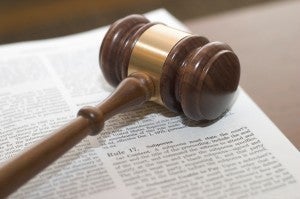 Like other major Clean Air Act standards protecting our climate and public health, the Clean Power Plan will likely be subject to numerous legal attacks.
Like other major Clean Air Act standards protecting our climate and public health, the Clean Power Plan will likely be subject to numerous legal attacks.
EPA has a long history of successfully defending its rules against such attacks – and the Clean Power Plan is on similarly strong legal footing.
Leading law enforcement officials, former EPA officials, and prominent legal scholars have concluded that the Clean Power Plan is firmly within EPA’s long-standing authority under the Clean Air Act:
Statements on the Final Clean Power Plan
We are in the process of reviewing the rules but fully anticipate standing with EPA to defend these necessary emission standards if they are challenged in court…The rules are also firmly grounded in the law. The Clean Air Act requires EPA to regulate emissions of climate change pollution from new and existing power plants. Furthermore, the rules set reasonable limits on these sources as a result of a multi-year stakeholder process that drew heavily on strategies states have used to successfully cut power plant emissions while growing our economies. — Attorneys General of New York, California, Connecticut, Maine, Massachusetts, New Mexico, Oregon, Vermont, Washington, the District of Columbia, and the Corporation Counsel of the City of New York, Letter to EPA Administrator Gina McCarthy, August 3, 2015
The new rules set reasonable limits on emissions of climate change pollution from new and existing power plants and are firmly grounded in law. My office stands ready to support and assist the EPA throughout the implementation of the plan, including in any legal challenges that may be filed in the courts. — George Jepsen, Attorney General of Connecticut, August 3, 2015
North Carolina’s Clean Smokestacks Act, our renewable energy standard and other forward-thinking efforts were forged by collaboration among interested parties such as utilities, environmentalists, businesses and consumer advocates. Our state is in a great position to bring these and other stakeholders together once again to work with the EPA to devise our own plan to protect North Carolina’s air and promote economic growth… I encourage the [North Carolina General Assembly] to avoid the path of litigation and instead work on a cooperative effort we can all be proud of. – Roy Cooper, Attorney General of North Carolina,letter to leaders of the North Carolina General Assembly, Aug. 7, 2015
[T]he government is on solid legal footing to defend the Clean Power Plan. — Profs. Jody Freeman and Richard J. Lazarus, Harvard Law School, The Biggest Risk to Obama’s Climate Plan May Be Politics, Not the Courts, The Guardian, August 5, 2015
[T]here is no question that in the final plan, the government has shored up its legal vulnerabilities and put itself in a far better position to defend its ambitious rule. — Prof. Jody Freeman, Harvard Law School,How Obama Plans to Beat His Climate Critics, Politico, August 3, 2015
Every president since [the late 1980s], whether a Democrat or Republican, has taken meaningful steps to slash pollution from existing plants, in most cases relying not on new legislation but on previously neglected provisions of the Clean Air Act itself… The Clean Power Plan follows in this bipartisan tradition… [T]he rule is the latest chapter in a decades-long effort to clean up our oldest, dirtiest power plants and at last fulfill the pledge that Congress made to the American people back in 1970: that the air we all breathe will be safe. — Prof. Richard Revesz and Jack Lienke, New York University School of Law, Obama Takes a Crucial Step on Climate Change, The New York Times, August 3, 2015
Statements on the Proposed Clean Power Plan
The EPA has authority under the 1990 Clean Air Act, an authority affirmed by the U.S. Supreme Court, to set these public health protections against carbon pollution. — Carol M. Browner, former EPA Administrator under President Bill Clinton, and Alex Laskey, With New Power Plant Rules, Energy Efficiency Checks All the Boxes, The Hill, June 2, 2014
Critics of the [Clean Power Plan] say that President Obama is making an end run around Congress, stretching the law to achieve by executive action what he could not accomplish through the legislative branch. This is flat wrong. More than four decades ago, Congress expressed its clear desire to regulate pollution from power plants, in the form of the Clean Air Act. I know, because I worked on the legislation, including the key part of the act—Section 111—that the Obama administration is using to justify its move. — Leon Billings, former Chief of Staff to Sen. Edmund Muskie and staff director of the Senate Environment Subcommittee during the drafting of the Clean Air Act, The Obscure 1970 Compromise That Made Obama’s Climate Rules Possible, Politico, June 2, 2014
Limiting Greenhouse Gas emissions from existing power plants is the next logical step after the Supreme Court and other courts have upheld EPA’s authority and obligation to address this issue. A system-wide approach provides needed flexibility and reduces costs, as well as encouraging investment in lower-emitting generation. EPA has wisely left the states a lot of discretion rather than mandating specific measures as some had wanted. — E. Donald Elliott, EPA General Counsel under President George H.W. Bush, Obama’s Section 111d Plan Has Support From George H.W. Bush’s EPA General Counsel, Utility Executives, Legal Planet, June 1, 2014
[I]t is important to be clear here: the President is required to issue the rules, required by law and by the interpretation of the law by the highest Court in the land. — Prof. Ann Carlson, UCLA School of Law, Obama Has To Issue Climate Change Rules — The Law Says So,Talking Points Memo, May 30, 2014









